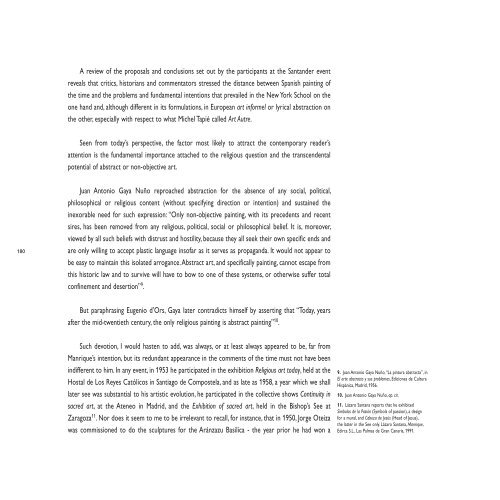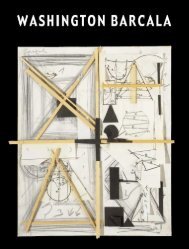VERSIÓN INGLESA ENGLISH VERSION - Fundación César Manrique
VERSIÓN INGLESA ENGLISH VERSION - Fundación César Manrique
VERSIÓN INGLESA ENGLISH VERSION - Fundación César Manrique
Create successful ePaper yourself
Turn your PDF publications into a flip-book with our unique Google optimized e-Paper software.
180<br />
A review of the proposals and conclusions set out by the participants at the Santander event<br />
reveals that critics, historians and commentators stressed the distance between Spanish painting of<br />
the time and the problems and fundamental intentions that prevailed in the New York School on the<br />
one hand and, although different in its formulations, in European art informel or lyrical abstraction on<br />
the other, especially with respect to what Michel Tapié called Art Autre.<br />
Seen from today’s perspective, the factor most likely to attract the contemporary reader’s<br />
attention is the fundamental importance attached to the religious question and the transcendental<br />
potential of abstract or non-objective art.<br />
Juan Antonio Gaya Nuño reproached abstraction for the absence of any social, political,<br />
philosophical or religious content (without specifying direction or intention) and sustained the<br />
inexorable need for such expression: “Only non-objective painting, with its precedents and recent<br />
sires, has been removed from any religious, political, social or philosophical belief. It is, moreover,<br />
viewed by all such beliefs with distrust and hostility, because they all seek their own specific ends and<br />
are only willing to accept plastic language insofar as it serves as propaganda. It would not appear to<br />
be easy to maintain this isolated arrogance. Abstract art, and specifically painting, cannot escape from<br />
this historic law and to survive will have to bow to one of these systems, or otherwise suffer total<br />
confinement and desertion” 9 .<br />
But paraphrasing Eugenio d’Ors, Gaya later contradicts himself by asserting that “Today, years<br />
after the mid-twentieth century, the only religious painting is abstract painting” 10 .<br />
Such devotion, I would hasten to add, was always, or at least always appeared to be, far from<br />
<strong>Manrique</strong>’s intention, but its redundant appearance in the comments of the time must not have been<br />
indifferent to him. In any event, in 1953 he participated in the exhibition Religious art today, held at the<br />
Hostal de Los Reyes Católicos in Santiago de Compostela, and as late as 1958, a year which we shall<br />
later see was substantial to his artistic evolution, he participated in the collective shows Continuity in<br />
sacred art, at the Ateneo in Madrid, and the Exhibition of sacred art, held in the Bishop’s See at<br />
Zaragoza 11 . Nor does it seem to me to be irrelevant to recall, for instance, that in 1950, Jorge Oteiza<br />
was commissioned to do the sculptures for the Aránzazu Basilica - the year prior he had won a<br />
9. Juan Antonio Gaya Nuño, “La pintura abstracta”, in<br />
El arte abstracto y sus problemas, Ediciones de Cultura<br />
Hispánica, Madrid, 1956.<br />
10. Juan Antonio Gaya Nuño, op. cit.<br />
11. Lázaro Santana reports that he exhibited<br />
Símbolos de la Pasión (Symbols of passion), a design<br />
for a mural, and Cabeza de Jesús (Head of Jesus),<br />
the latter in the See only. Lázaro Santana, <strong>Manrique</strong>,<br />
Edirca S.L., Las Palmas de Gran Canaria, 1991.
















![Becas y premios de la Fundación César Manrique [1997-2006]](https://img.yumpu.com/20766851/1/184x260/becas-y-premios-de-la-fundacion-cesar-manrique-1997-2006.jpg?quality=85)
